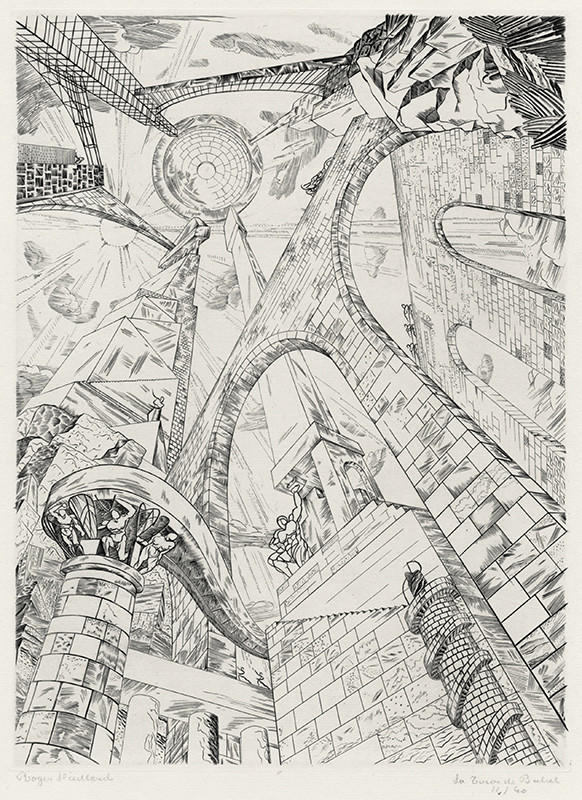Tour de Babel is an engraving from 1935 by the French artist Roger Vieillard. It is pencil signed, titled, and editioned 11/40. The references are Ashmolean 6 and Vieillard 21. Tour de Babel was printed by the artist at Atelier 17 on ivory laid Vidalon France watermarked paper and the platemark measures 14-7/8 x 10-5/8 inches. The alternative title is Architecture II.
Vieillard was inspired to create this print after walking beneath the Eiffel Tower. He drew the tower from the inside as its soars toward the sky, architectural elements supporting each other with fragility. Hacker wrote about this engraving on page 12: “Tour de Babel is an invention of which Piranesi himself would have been envious, for nothing since the Carceri even approximates to this dazzling, vertiginous tour de force. ...the Tower of Babel is depicted from the inside, looking upwards. The structure consists of vast arches, huge columns and pilasters, winding stone staircases and bridges supported by giant caryatids, all ascending to the dizzy heights of a dome that floats almost weightlessly above….A nice detail is added by a minute penseur, seated on a pilaster at top left, ‘contemplating the absurdity of it all’.”
Roger Vieillard was born in Mans, France on 9 February 1907 and was classically educated in Paris. Besides being a noted international tennis player, he worked as a meteorologist in the army in 1930. In the early 1930s, he began making wire sculptures, as Alexander Calder had done earlier and, in 1934, Vieillard met Stanley William Hayter who showed him how to use the burin to create an active line on copper. He began working in the evenings at Atelier 17 and formed a close friendship with Hayter and printmaker Joseph Hecht.
In 1931, Vieillard took a position with the Banque Nationale pour le Commerce et l’Industrie. He opened his own press with artist Georges Lecoq-Vallon in 1937 and published his first of many illustrated books, Apollinaire’s Salomé.
Vieillard married American artist Anita de Caro in 1938 and began working in his own studio producing illustrated books while continuing to exhibit with Atelier 17. In 1940, he was conscripted into the army, working as a meteorologist in the French Army.
Over the next forty years Vieillard continued to create prints, both as unique artworks and as illustrations for his own livres d'artiste. In the early 1960s he created plaster prints, a technique which had evolved at Atelier 17 in the 1930s. He retired from the bank in 1967 and was elected president of the Société Peintres-Gravures Francais in 1970. Vieillard created 332 prints between 1934 and 1989 and his work is represented in museums in France and the Museum of Modern Art and the Metropolitan Museum in New York.
Roger Vieillard died in Paris on 1 March 1989.



